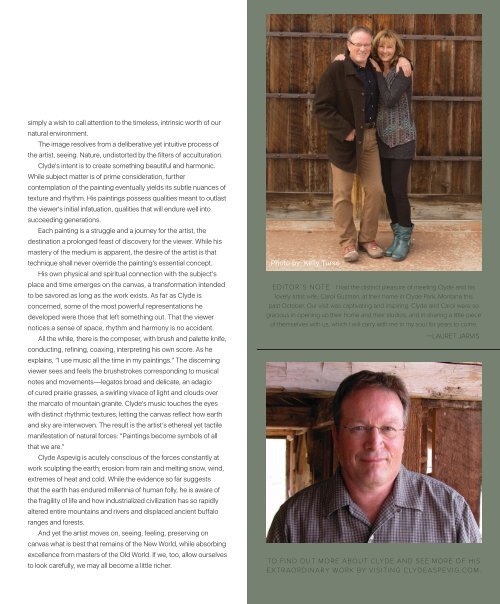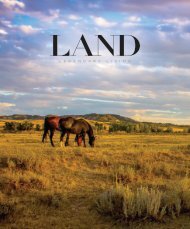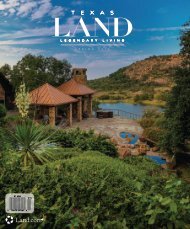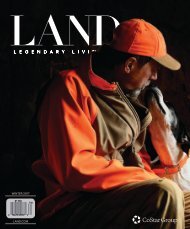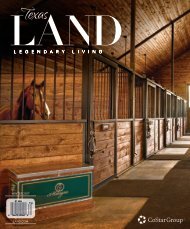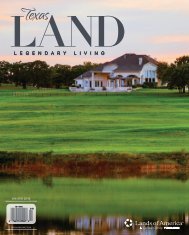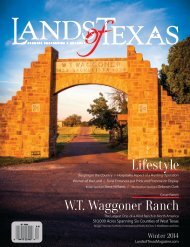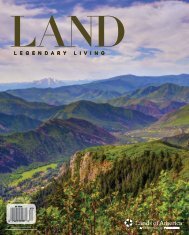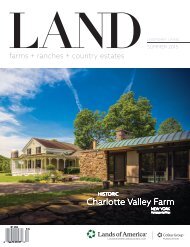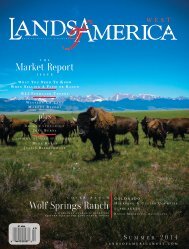You also want an ePaper? Increase the reach of your titles
YUMPU automatically turns print PDFs into web optimized ePapers that Google loves.
simply a wish to call attention to the timeless, intrinsic worth of our<br />
natural environment.<br />
The image resolves from a deliberative yet intuitive process of<br />
the artist, seeing. Nature, undistorted by the filters of acculturation.<br />
Clyde's intent is to create something beautiful and harmonic.<br />
While subject matter is of prime consideration, further<br />
contemplation of the painting eventually yields its subtle nuances of<br />
texture and rhythm. His paintings possess qualities meant to outlast<br />
the viewer's initial infatuation, qualities that will endure well into<br />
succeeding generations.<br />
Each painting is a struggle and a journey for the artist, the<br />
destination a prolonged feast of discovery for the viewer. While his<br />
mastery of the medium is apparent, the desire of the artist is that<br />
technique shall never override the painting's essential concept.<br />
His own physical and spiritual connection with the subject's<br />
place and time emerges on the canvas, a transformation intended<br />
to be savored as long as the work exists. As far as Clyde is<br />
concerned, some of the most powerful representations he<br />
developed were those that left something out. That the viewer<br />
notices a sense of space, rhythm and harmony is no accident.<br />
All the while, there is the composer, with brush and palette knife,<br />
conducting, refining, coaxing, interpreting his own score. As he<br />
explains, “I use music all the time in my paintings.” The discerning<br />
viewer sees and feels the brushstrokes corresponding to musical<br />
notes and movements—legatos broad and delicate, an adagio<br />
of cured prairie grasses, a swirling vivace of light and clouds over<br />
the marcato of mountain granite. Clyde's music touches the eyes<br />
with distinct rhythmic textures, letting the canvas reflect how earth<br />
and sky are interwoven. The result is the artist’s ethereal yet tactile<br />
manifestation of natural forces: “Paintings become symbols of all<br />
that we are.”<br />
Clyde Aspevig is acutely conscious of the forces constantly at<br />
work sculpting the earth; erosion from rain and melting snow, wind,<br />
extremes of heat and cold. While the evidence so far suggests<br />
that the earth has endured millennia of human folly, he is aware of<br />
the fragility of life and how industrialized civilization has so rapidly<br />
altered entire mountains and rivers and displaced ancient buffalo<br />
ranges and forests.<br />
And yet the artist moves on, seeing, feeling, preserving on<br />
canvas what is best that remains of the New World, while absorbing<br />
excellence from masters of the Old World. If we, too, allow ourselves<br />
to look carefully, we may all become a little richer.<br />
Photo by: Kelly Turso<br />
EDITOR’S NOTE I had the distinct pleasure of meeting Clyde and his<br />
lovely artist wife, Carol Guzman, at their home in Clyde Park, Montana this<br />
past October. Our visit was captivating and inspiring. Clyde and Carol were so<br />
gracious in opening up their home and their studios, and in sharing a little piece<br />
of themselves with us, which I will carry with me in my soul for years to come.<br />
—LAURET JARVIS<br />
TO FIND OUT MORE ABOUT CLYDE AND SEE MORE OF HIS<br />
EXTRAORDINARY WORK BY VISITING CLYDEASPEVIG.COM.<br />
LANDSOFAMERICAMAGAZINES.COM<br />
23


